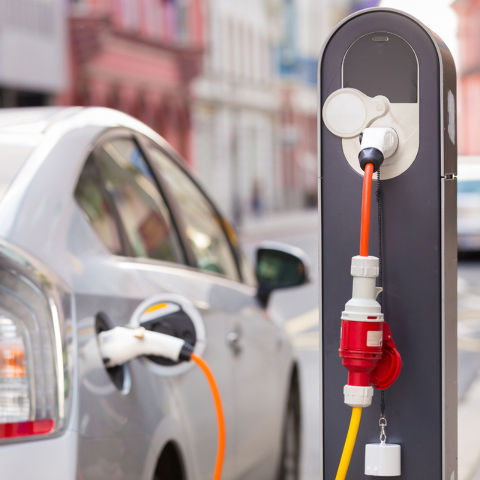Making Green Living Colorful and Smart
In our present election environment, dominated by “red”-talk and “blue”-talk, it is sometimes difficult to discuss green living.
Like politics, the topic appears to be bifurcated into two camps — either for the environment or against it. However, liberal thinking and conservative ideas can blend together into smart, colorful choices, if we are bold enough to choose.
Mixing Colors
Recently, our daughters took my husband and I to one of those dine and design places, where they teach you how to paint in a group setting. My husband is a natural artist; however, I have trouble drawing even a recognizable stick person. I had decided in my head, before even trying, that I would not like it. Surprisingly, my painting was not a complete disaster, and I was amazed at the variety of beautiful hues we all made by mixing our primary colors.
Green living is similar. While political ideology on both sides of the aisle have areas of deep concern, on the individual level, there is still so much we can all agree upon. Both Liberals and Conservatives agree on conserving our funds and natural resources.
Here are a few things on which I think we all can agree.
■ Clean, safe water and air is a public good that is important for everyone.
■ Saving money is good.
■ Staying informed of facts helps us make informed decisions.
■ Change is hard.
■ People can change things.
There is a familiar test that the poet Rumi offers us before speaking: Is it true? Is it necessary? Is it kind? I have my own test when it comes to green living: Is it smart? Is it efficient? Is it necessary?
Is it smart?
We wouldn’t be searching for ways to be more efficient and conserve if we weren’t struggling with challenges that are real.
Gavin Schmidt, a climatologist, climate modeler and the director of the NASA Goddard Institute for Space Studies, explains the big picture of climate change and how we have a huge, complex, ever-changing challenge on our hands. Thousands of specialists around the globe work hard to create models that help us try to predict the future conditions. Schmidt makes it clear in his TED Talks, “The Emergent Patterns of Climate Change,” that models are not right or wrong. They are, however, considered skillful if they tell us more information then we would have had otherwise.
Over time these models are compared to the observed data. The outcome of these long-term comparisons help us to see some general possible future outcomes. The outcomes of making some changes, aggressive changes, or no changes at all during this century are drastically different. The red hue symbolizing heat in the business-as-usual model is alarming at best.
The Nobel Laureate F. Sherwood Rowland, who worked on the decomposition of the ozone, said, “What is the use of having developed a science well enough to make predictions if, in the end, all we’re willing to do is stand around and wait for them to come true?”
Is it efficient?
The scientific consensus on climate change is clear on two matters: The global climate is changing, and human activity contributes significantly to this trend. The Intergovernmental Panel on Climate Change concludes that, “the human influence on the climate system is clear and is evident from the increasing greenhouse gas concentrations in the atmosphere, positive radiative forcing, observed warming and understanding of the climate system.”
If we are as near to a tipping point as many models predict, speedy, full-out efforts to lower our emissions in every way possible is the most efficient path.
My goal when accepting the challenge of writing this column was to write on topics that connect and empower people; that make them want to learn more, do more, and start talking and sharing more with others, regardless of political leanings.
This has led me to write on topics that we all can get behind like saving water, eating smarter, shopping less, supporting local whole food growers, making changes in travel and taking initiatives in living more sustainable lives.
It is easy to blame or criticize businesses, government and others. However, focusing on what we can do seems more productive.
Is it necessary?
This past week in my American Politics class we discussed the American dream. As Benjamin Franklin summed it up, “If you are talented and work hard, you can achieve financial success.” Admittedly, houses, cars, electronics and things are great, but as my students pointed out, maybe the American dream promotes the wrong values.
“Is it necessary?” is a handy question to ask before adding to our possessions. How much is enough? We live in a world of finite resources. Considering the full life cycle of the products and resources we use may help us decide if the next purchase is really necessary.
We can show respect for our planet and future generations by conscientiously working for a sustainable future. We also can be fiscally and physically conservative in our use of resources.
In reality, this is not a two-sided challenge with a silver-bullet solution. This a complex challenge needing a palette of colorful mixed ideas and actions from everyone. We need smart ideas like rooftop solar, urban farming and ride-sharing. We need efficient actions like reusing water containers, smart meters to help us reduce energy usage, and electric or hybrid vehicles. Finally, we need necessary actions like drastically reducing unnecessary consumption. These are powerful actions we all can stand behind. Imagine what colorful changes could occur if we all take action.
Mary Beth Horiai has split her adult life between Japan and Southern Nevada. In Las Vegas, Horiai works for the nonprofit, Green Our Planet. A graduate of UNLV, she was trained as a speaker for The Climate Reality Project and also teaches part-time at College of Southern Nevada. For more information and links to additional resources relating to this column, visit driverofchange.net.



















